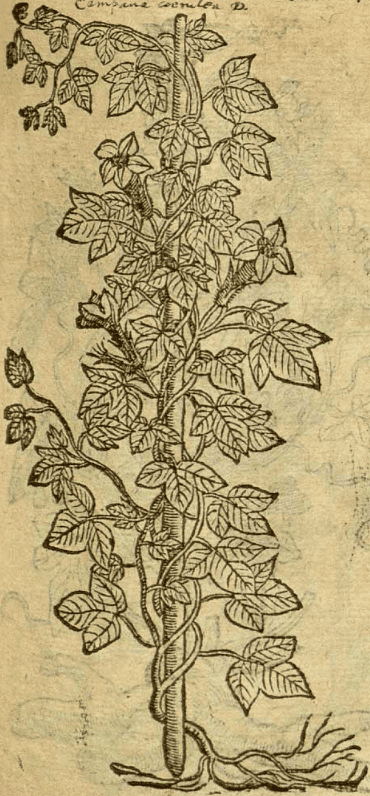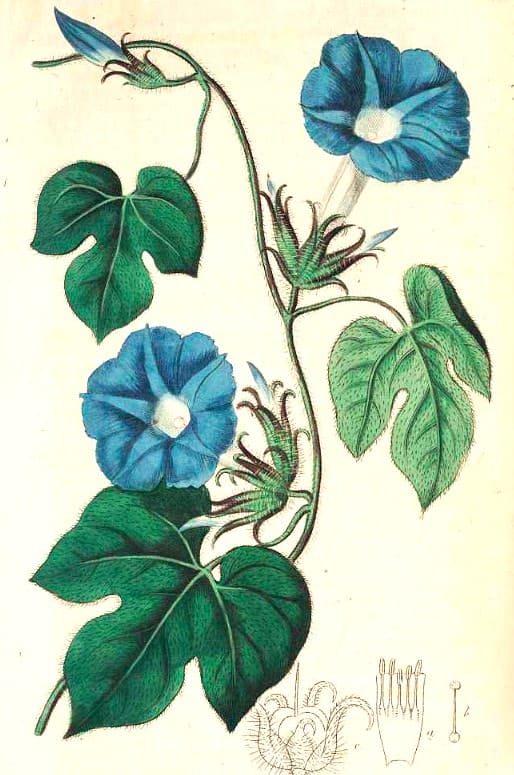Pharbitis, Qian Niu Zi 牵牛子Morning Glory seed; Pharbitis SeedQian Niu Zi (TCM) Habul Nil (Arabic) Kalandana (Unani) Kaladana, Kalanjani, Shankhani, (Ayurveda) |

|

|
 Ipomoea nil (as Convolvulus Hederacea)
Ipomoea nil (as Convolvulus Hederacea)Lobel, M. de, Plantarum seu stirpium icones (1581)
 Pharrbitis
PharrbitisBotanical Register, vol. 1 (1815)
Botanical name:
Pharbitis spp.
- P. nil (syn. Ipomoea nil, I. hederacea, Convolvulus nil, C. hederacea, C. bilobatus)
- P. purpurea (syn. Convolvulus purpurea)
Parts used:
Seed
White and Black seed varieties are known. Traditionally, the Black seeds were considered better to pass water from the Kidneys and the White seed, better for clearing Damp and Phlegm from the Lungs. Today, they are both used synonymously.
Temperature & Taste:
Warm, dry. Bitter, Pungent. Slightly Toxic
Considered Cold in modern TCM. ‘It is pungent and hot. If it is chewed for a long time, one will feel its strong function. How could it be bitter and cold?’ (Li Gao)
Classification:
E. Laxative, Purgatives and Cathartics
Uses:
1. Opens the Bowels, Purges Water, Promotes Urine:
-obstinate constipation in the strong; Constipation from Damp-Heat or Food obstruction
-serious Edema, Ascites
-in Unani as a purgative in deranged, excess or ill-formed Humors, especially Phlegm or Burnt Bile.
2. Clears Phlegm and Damp:
-Fluid obstructing the chest with Cough, Wheezing
-fullness in the chest and abdomen from phlegm and damp
-throat pain, pharyngitis, globus hystericus
-has been used for nasopharyngeal cancer
3. Kills Worms:
-Roundworm, Tapeworm
-abdominal pain and Food Stagnation associated with Worms
-Scabies
4. Externally:
-Leukoderma, Vitiligo, apply a paste of the seeds or an ointment made from them
-has successfully been used for polyps of the vocal cords
Dose:
Decoction: 3–6 grams (up to 9 grams) crushed before using.
Powder or Pills: 1–3 grams (maximum daily dose is 3 grams)
The resin has been extracted and used for Jalap, in doses of 2–8 grains (130–500mg)
Preparation:
1. Stir-Fried Pharbitis Seeds:
The seeds are Stir-fried until slightly swollen and start to pop. This moderates their drastic effect and lessens side effects. This is commonly practiced in India, and is also recommended in TCM, where reportedly in some parts of China roasting is done as a matter of course. It is best to use this preparation for internal use.
According to Li Shi Zhen, people in his time used equal parts of raw and stir-fried seeds.
2. Pharbitis Kernels:
The husk was considered most toxic, so it was common practice in the past to use the seed kernels. This is not commonly done today.
3. Prepared Pharbitis seed:
Dry the seeds in the sun, rinse in water to remove the foam, then dry in the sun. Steep in wine, then steam, and dry again in the sun. Remove the husks before use. (Lei Xiao)
Correctives:
1. Almond oil
2. Raisin or Fig extract
3. Lemon; Citrus fruit
4. Rose; Chebulic Myrobalan (reduce cramping)
5. Ginger ‘reinforces’ the effect as Pharbitis. (Li Shi Zhen)
Substitutes:
1. Colocynth pulp
2. Jalap (Morning Glory seeds are used as a substitute for Jalap)
3. Rue seed
Main Combinations:
1. Edema:
i. Pharbitis Qian Niu Zi with Cornus Shan Zhu Yu.
ii. Pharbitis Qian Niu Zi with abdominal distention from Cold or Yang deficiency, with Aloeswood (Chen Xiang) and Cinnamon.
iii. to increase efficacy Pharbitis Qian Niu Zi with Magnolia bark (Hou Po), Costus root
iv. Pharbitis Qian Niu Zi with Fennel seed, Costus
v. from Nephritis, Pharbitis Qian Niu Zi with fresh Ginger, Jujubes (Da Zao), Brown Sugar, form pills.
vi. Pharbitis Qian Niu Zi, Beteal nut (Bing Lang), Costus Mu Xiang, Citrus Chen Pi, Poria Fu Ling (or each 9 grams). Decoct to be taken in 2 doses, (Qian Niu Tang)
2. Ascites:
i. Pharbitis Qian Niu Zi with Euphorbia Gan Sui
ii. Pharbitis Qian Niu Zi with Costus Mu Xiang, Magnolia Hou Po
iii. from Cirrhosis, Pharbitis Qian Niu Zi with fresh Ginger, Jujubes (Da Zao), Brown Sugar, form pills.
3. Constipation:
i. Pharbitis Qian Niu Zi with Peach kernel (Tao Ren), both powdered and made into pills
ii. Pharbitis Qian Niu Zi with Peach kernel (Tao Ren), Rhubarb (Da Huang)
iii. Pharbitis Qian Niu Zi with Cream of Tartar, Ginger (Ayurveda)
4. Abdominal pain and constipation from worms, Pharbitis Qian Niu Zi with Betel nut (Bing Lang)
5. Hot abdominal pain, Pharbitis Qian Niu Zi with Rhubarb (Da Huang), Betel nut (Bing Lang), Citrus Zhi Shi, Magnolia Hou Po, Sparganium San Leng, Zedoary (E Zhu) (as in Qian Niu Da Huang Wan)
6. To purge foul or excess Humors:
i. Pharbitis Qian Niu Zi with Rose (Unani)
ii. Pharbitis Qian Niu Zi with Chebulic Myrobalan (Unani)
iii. Pharbitis Qian Niu Zi with Black Pepper, Ginger (Unani)
iv. to purge the Blood, Pharbitis Qian Niu Zi with Rhubarb (Da Huang)
7. Cough, Wheezing and fullness in the chest from fluid congesting the Lungs:
i. Pharbitis Qian Niu Zi with Almond kernel (Xing Ren), Lepidium Ting Li Zi
ii. Pharbitis Qian Niu Zi with Rhubarb (Da Huang), Betel nut (Bing Lang)
8. Gastro-duodenal Ulcers, Pharbitis Qian Niu Zi with has been successfully combined in clinical trials with Cattail Pollen (Pu Huang), Flying Squirrel Feces (Wu Ling Zhi) and Cuttlefish Bone
9. Chronic Pharyngitis, Pharbitis Qian Niu Zi with Trichosanthes Root (Tian Hua Fen), Lonicera Jin Yin Hua, Perilla Zi Su Zi, Bamboo Shavings (Zhu Ru)
Cautions:
1. Not used in Pregnancy or the very weak
Drug Interactions:
Incompatible with Croton seed
Toxicity:
1. Large doses are toxic to the gastrointestinal tract, urinary system and nervous system.
2. Overdose causes dizziness, headache, vomiting, abdominal pain, diarrhea with mucus, hematuria, increased heart rate; severe overdose reactions include fever, loss of consciousness, cold extremities, cyanosis of the lips and nails, and shortness of breath.
3. Toxic symptoms are usually noted in dosage range of 15–45 grams. A fatality has been reported following a dose of 195 grams.
Antidotes:
1. Decoction of 120 grams of Mung Beans (Lu Dou).
2. Gall powder (Wu Bei Zi) 12 grams, 6 Egg Whites and 60 grams of Honey, mixed into warm water and given as a dose.
3. A compound which has been useful for overdose: Astragalus Huang Qi 30 grams, Agrimony (Xian He Cao) 30 grams, Codonopsis Dang Shen 30 grams, Atractylodes Bai Zhu 9 grams, Poria Fu Ling 9 grams, Gardenia Zhi Zi 9 grams, Coptis Huang Lian 6 grams. (Chinese Medical Herbology and Pharmacology, Chen and Chen, 2001)
